This post may contain paid links. See more info on my privacy page.
Want to know how to pan fry asparagus? This is the recipe for you! Bright, fresh, and perfectly crisp, my recipe for Pan Fried Asparagus makes a beautiful side dish for any meal. Using only a handful of ingredients and coming together in under 20 minutes, this asparagus is so tasty, you'll want to eat it right out of the pan!
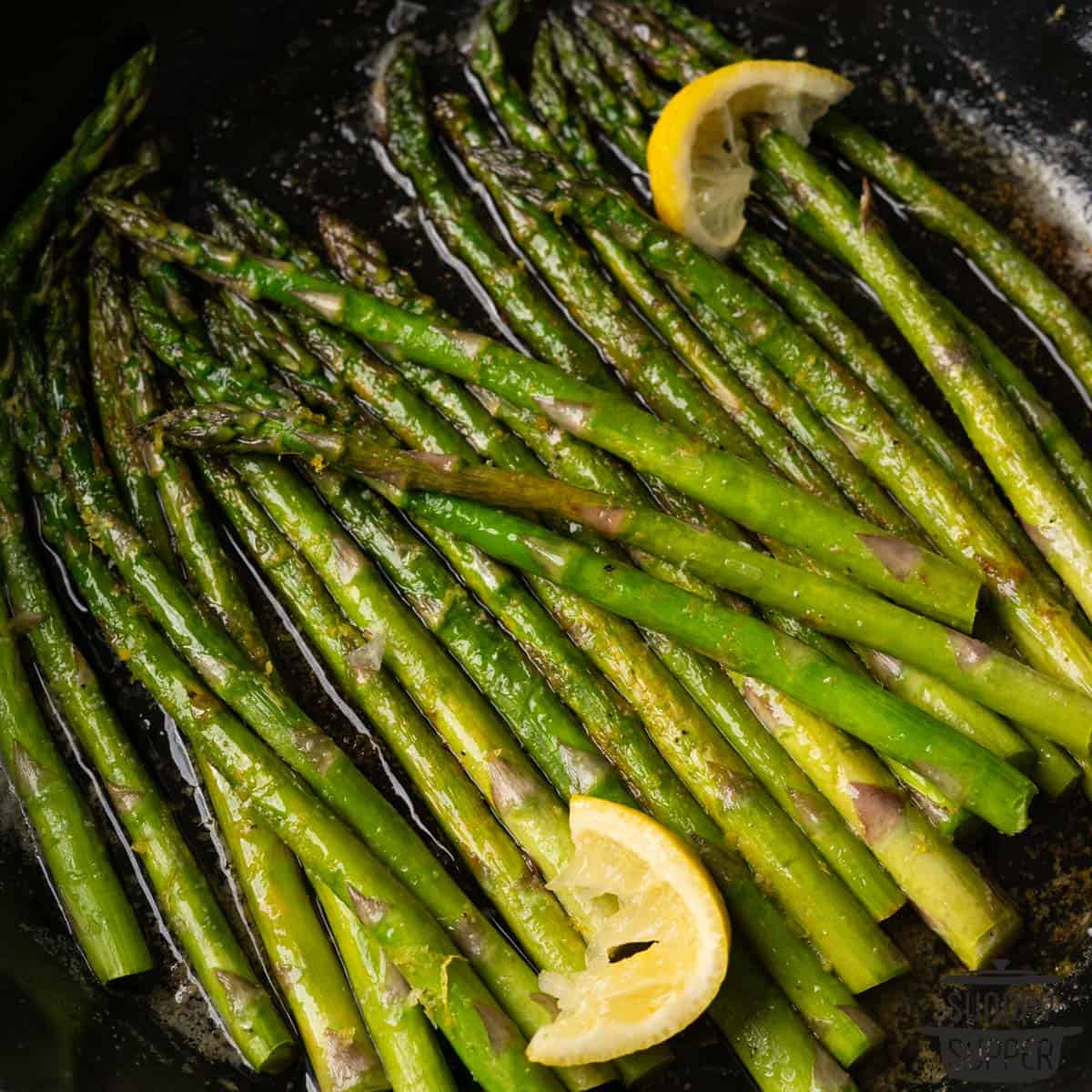
Jump to:
- Sauteed Asparagus
- Reasons to Cook Asparagus in a Pan
- Sauteed Asparagus Recipe Ingredients
- How to Trim Asparagus
- How to Pan Fry Asparagus
- Sauteed Vegetables
- Asparagus Pan Fried Tips
- Storing and Reheating Asparagus
- Pan Fried Asparagus Recipe FAQ
- What to Serve with Asparagus
- Pan Frying Asparagus
- Pan Fried Asparagus
- Reviews
Sauteed Asparagus
If I have to pick a favorite vegetable, it might just be asparagus. I've tried just about every classic asparagus dinner recipe you can think of, from air fried and oven roasted to bacon-wrapped and grilled, but if I had to choose just one method to use, it might be sauteing asparagus.
Cooked crispy golden with rich, silky butter and olive oil, plus a bright splash of lemon, pan fried asparagus is a side dish you can count on disappearing before the main course. If you want to learn how to cook asparagus, learning how to pan fry asparagus is the perfect way to go!
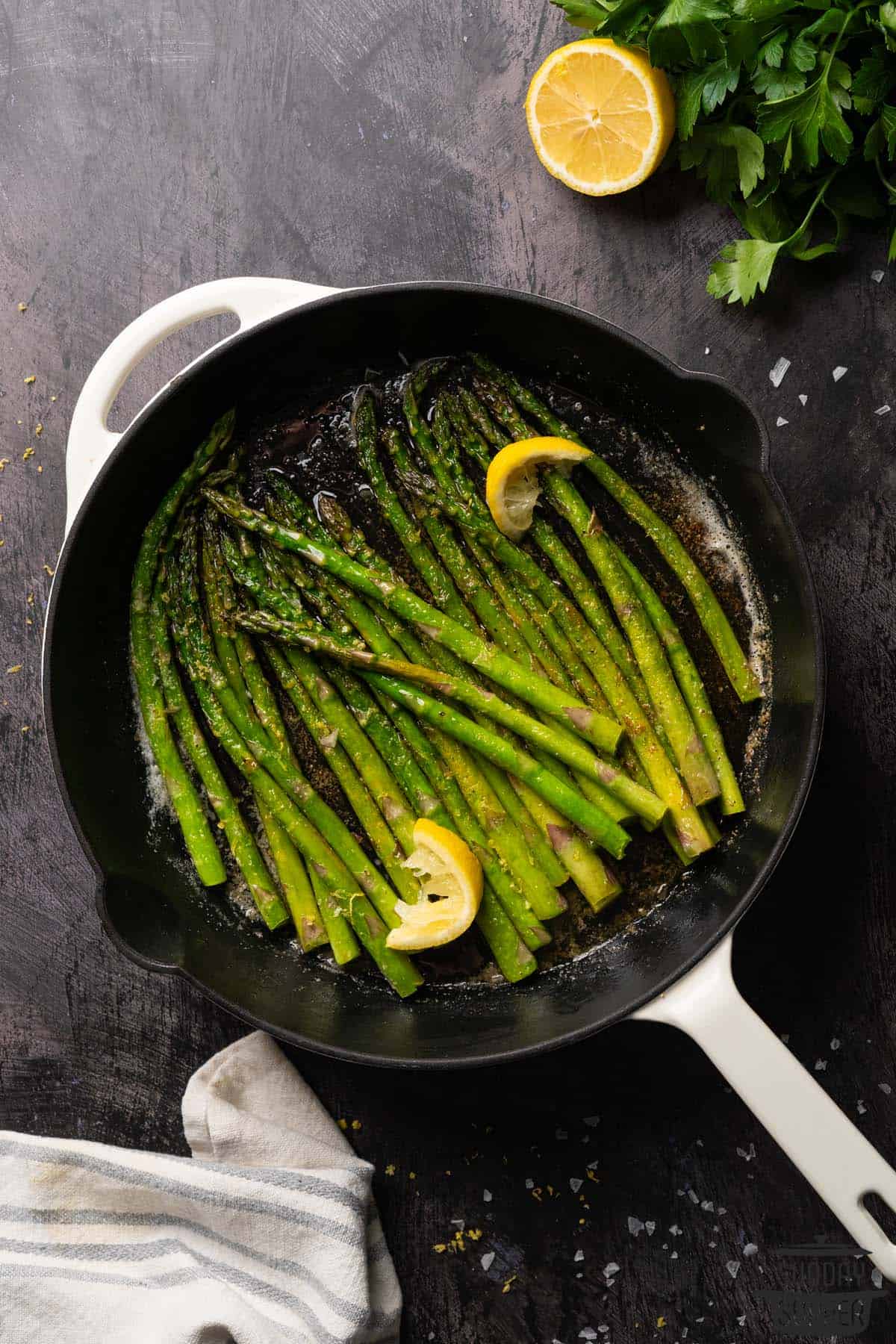
Reasons to Cook Asparagus in a Pan
Sauteed asparagus is so tender
Asparagus has a tender chew, with a buttery-soft stem and crispy leaves. Pan fried asparagus gives you all of that crisp and tender softness in one. It's totally irresistible!
Each bite of pan asparagus is flavorful
There are a million delicious ways to season asparagus, but using fresh lemon has got to be one of the best. It brings out all the brightness of the vegetable without overpowering its natural flavor, and pairs perfectly with other seasonings like Parmesan and garlic. I love it with my roasted vegetable seasoning. Plus, when you're cooking asparagus in a frying pan, it's easy to perfectly coat the veggies.
Pan frying asparagus is easy
One pan and a spatula - that's all you need! With how fast and easy it is to pan fry asparagus, this is one of my favorite side dishes for serving with main courses like a decadent steak reverse seared, roasted chicken in the oven, or roasted prime rib.
Sauteed Asparagus Recipe Ingredients
- Butter: You can leave the butter out if you prefer to use just oil or if you want a vegan side dish, but butter helps crisp up the asparagus as well as giving it a richness and flavor that oil alone can't quite capture.
- Olive oil: A high quality olive oil is a must! It adds a smooth, silky flavor and texture that softens the skin on asparagus, leaving the stalks tender and buttery. Look for real olive oil.
- Asparagus: I recommend using thin asparagus spears, especially for pan-frying asparagus. This makes for nice, crispy asparagus with crunchy leaves and a delectable flavor! Make sure to trim it first following my guide below!
- Salt: Use a nice flaky salt like Maldon sea salt flakes or kosher salt. Don't over-do it, though! It's easy to over-salt vegetables.
- Pepper: A sprinkle of pepper is all it takes to add extra depth of flavor!
- Garlic powder: I prefer to use garlic powder instead of fresh cloves. While fresh has a zingier flavor, the powder holds up better when sauteed, as fresh cloves are more likely to burn. But if you want to use fresh garlic, you could pair my pan-fried asparagus with garlic compound butter.
- Lemon zest: Fresh lemon zest sprinkled over the asparagus at the end brings brightness that makes this easy side dish feel extra fancy!
- Lemon juice: A squeeze of lemon juice brightens the dish, making for a fresh-tasting side.
Of course, there are a ton of great options for flavors! If you want, you can try any of these, too!
- Balsamic vinegar or balsamic glaze
- Parmesan cheese
- Fresh herbs (I like parsley or dill)
- Crumbled goat cheese
- Bacon crumbles
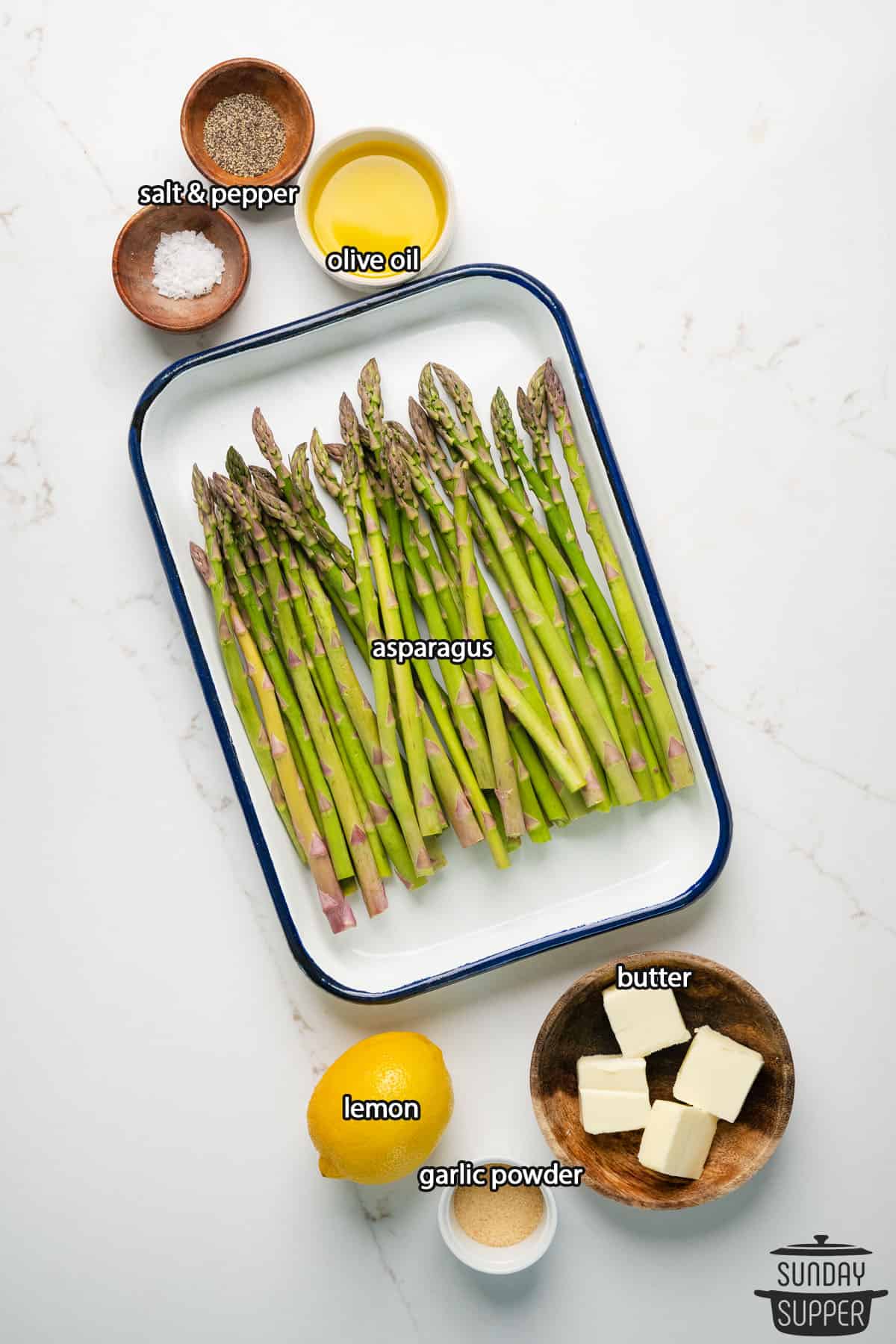
How to Trim Asparagus
In my years of experience, the best way to trim asparagus and get the most out of it is to slice off the woody ends with a sharp kitchen knife. Don't be tempted to snap the asparagus - it doesn't always break where it should, and you'll lose out on tasty stalks!
Just lay the asparagus flat on a cutting board, then cut off the last 1-2 inches of the stem, depending on how thick the stems are (thicker stems need more removed).
Make sure to rinse the asparagus well to wash away any clinging dirt or pesticides!
How to Pan Fry Asparagus
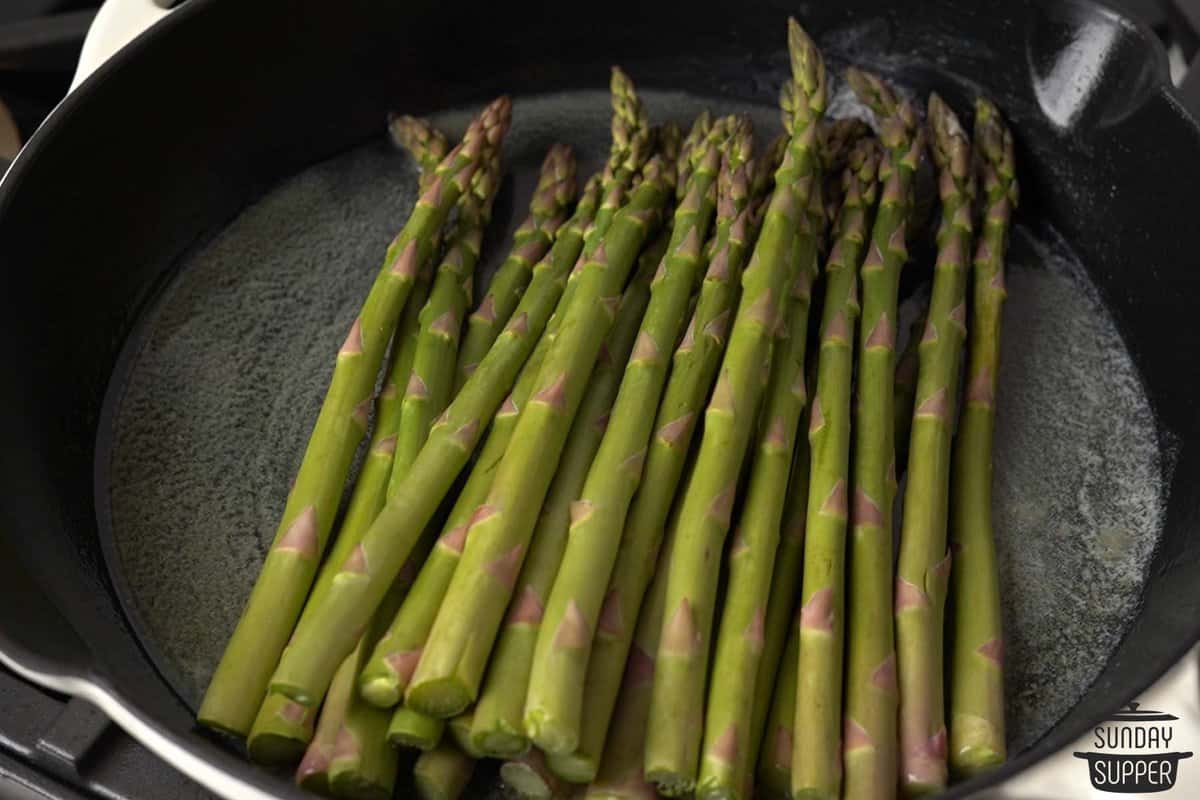
1: Heat the Butter
Melt butter in a skillet over medium-high heat. Once melted, add the trimmed asparagus and toss in butter.
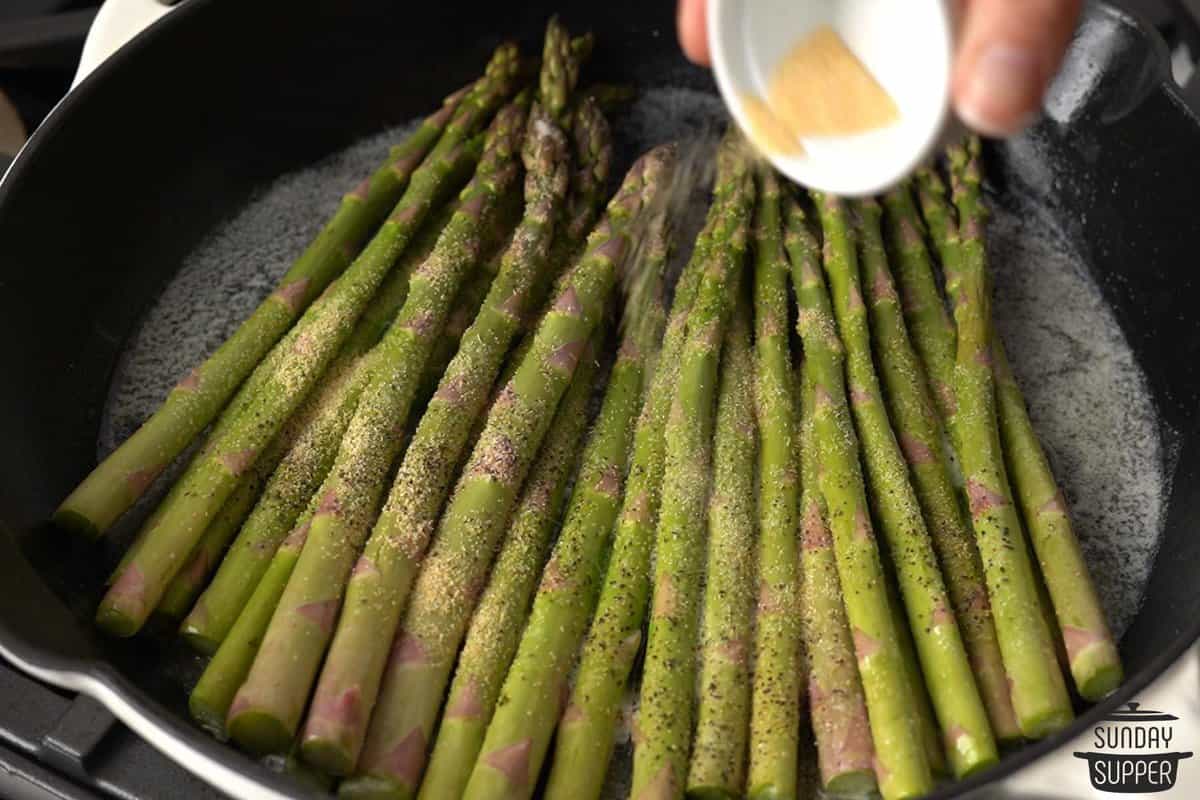
2: Add Seasonings
Add in olive oil, garlic powder, salt, and pepper. Mix well.
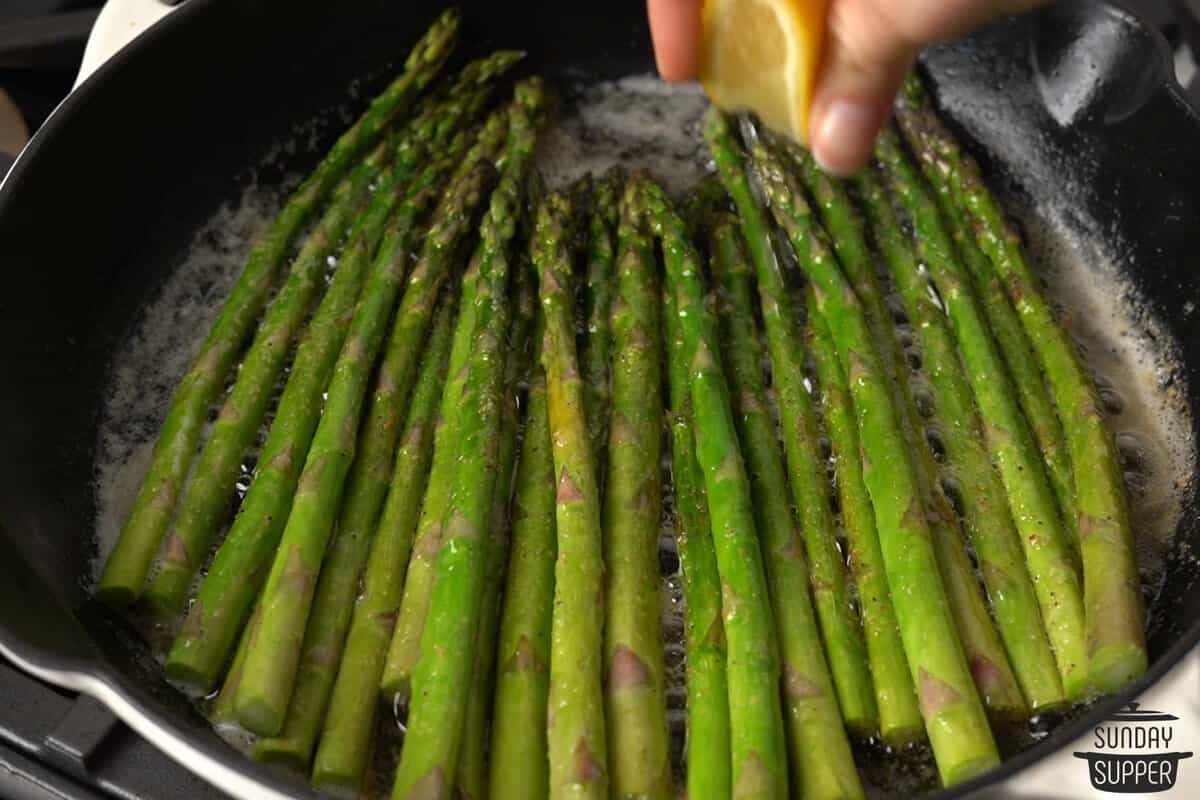
3: Saute Asparagus
Turning often to ensure even cooking, saute the asparagus for about 8-10 minutes, or until to your preferred level of doneness.
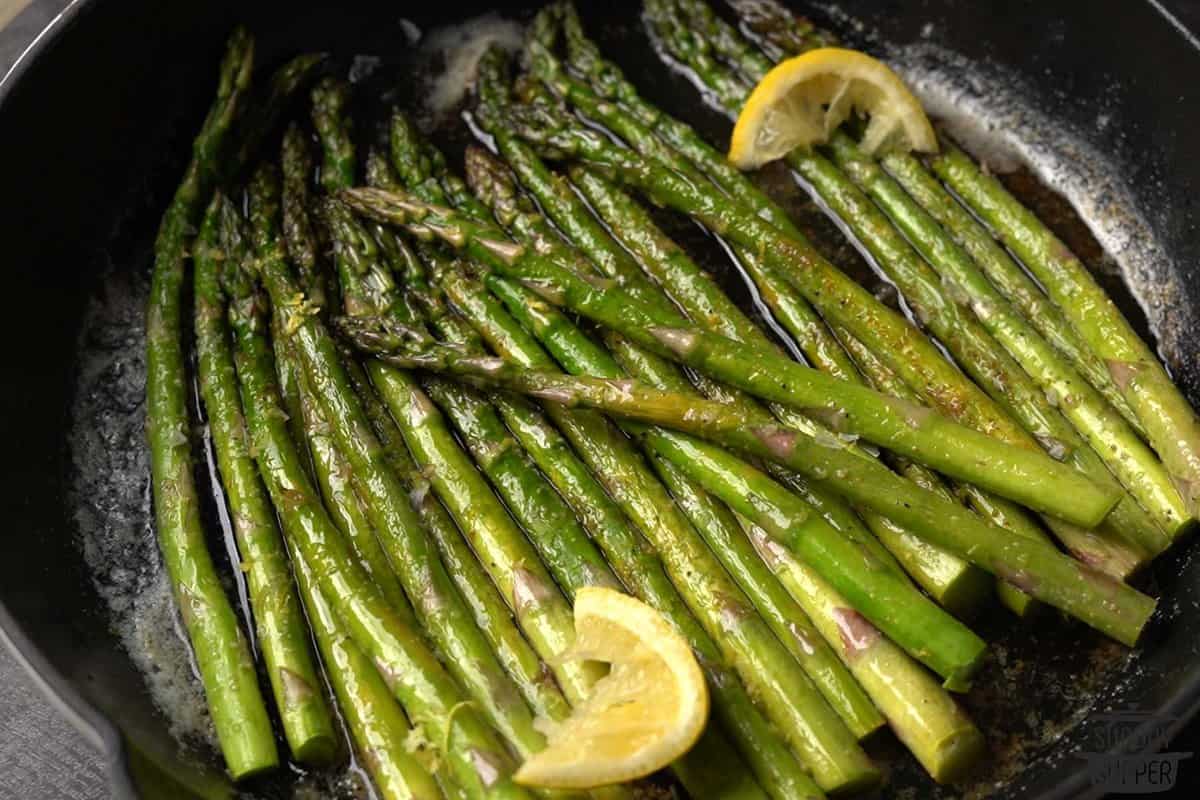
4: Garnish & Serve
Garnish the asparagus with a squeeze of lemon juice and a sprinkle of lemon zest, and give one more stir. Then serve, and enjoy!
Asparagus Pan Fried Tips
- This side is delicious year-round, but I especially recommend it in spring when asparagus is in season. The difference in the quality is truly remarkable.
- A little sprinkle of parmesan on top of the asparagus complements the lemon beautifully.
- If you want to use fresh garlic, add it after the asparagus has cooked for a few minutes. That way it will season the butter and add flavor without risking burning and turning bitter.
- It's better to cook asparagus in batches versus over-crowding the pan! The secret to how to saute asparagus on the stove is to keep each spear in contact with the heat so it crisps nicely.
- If you can, roll or flip the asparagus spears instead of stirring them as they get close to done to keep their shape.
Pans for Pan-Frying Asparagus
My favorite pan for asparagus is a good heavy cast-iron skillet. Cast-iron cooks much faster than nonstick, so it can be a little trickier to avoid burning the vegetables, but it provides a truly unique char and flavor that no other pan can quite achieve. If you don't have one, you can use a nonstick skillet.
Storing and Reheating Asparagus
- Refrigerator: Leftover asparagus can be stored in airtight containers or plastic bags in the fridge for up to 5 days.
- Freezer: You can freeze sauteed asparagus! Let it cool entirely before placing it in a freezer safe bag or airtight container. I recommend storing it with any leftover oil or butter to ensure that the asparagus doesn't dry out.
- Thawing: Thaw frozen asparagus in the fridge overnight, or place it frozen in a pan and heat over low heat until hot.
- Reheating: I tend to reheat asparagus in the microwave, but you can also place it in a pan or in the air fryer for a few minutes to get it crispy again.
Pan Fried Asparagus Recipe FAQ
You can pan fry frozen asparagus. When you pan-fry asparagus from frozen, it helps crisp up the outside that can otherwise get too soft, and helps retain the moisture and tenderness of the stalks.
The cook time is really up to you and your taste preferences! I tend to like asparagus nice and crispy-crunchy, with a very soft stalk. This means cooking it until the stem has started to turn golden brown and the leaves are starting to crisp up and turn dark, about 10 minutes.
Cutting the stalks with a knife is easier, faster, and wastes less food than snapping asparagus, which often wastes edible portions of the stalk. Just cut them about 1-2 inches above the end of the stem, above any white parts.
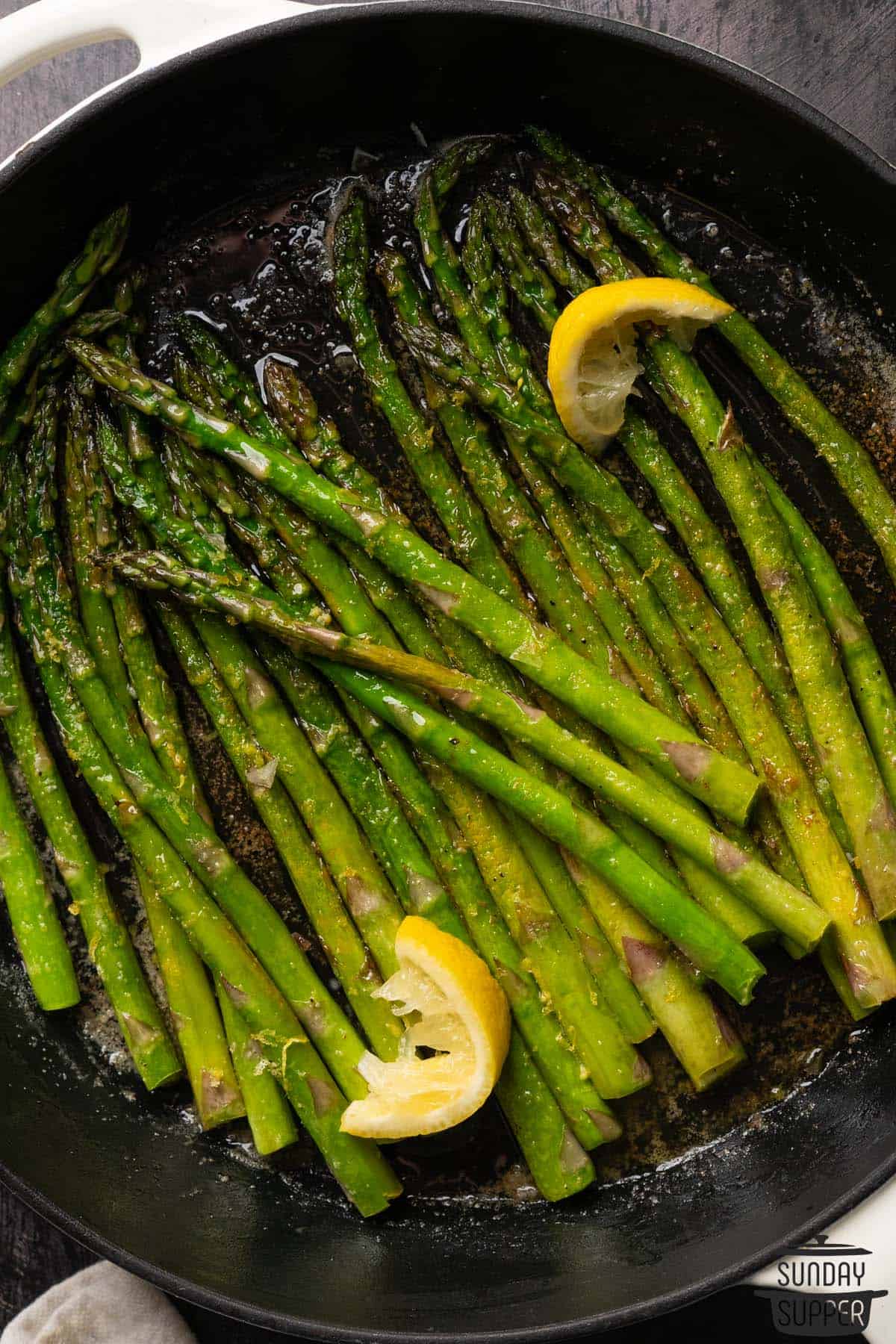
What to Serve with Asparagus
Pan Frying Asparagus
Don't tell Ron, but every time I make pan fried asparagus to serve with dinner, I wind up eating a few stalks before it makes it to the table. It's so hard to resist snacking on that it's honestly a miracle there's any left at all! I know you're going to love it. Leave a comment and a rating below to let me know what you think!
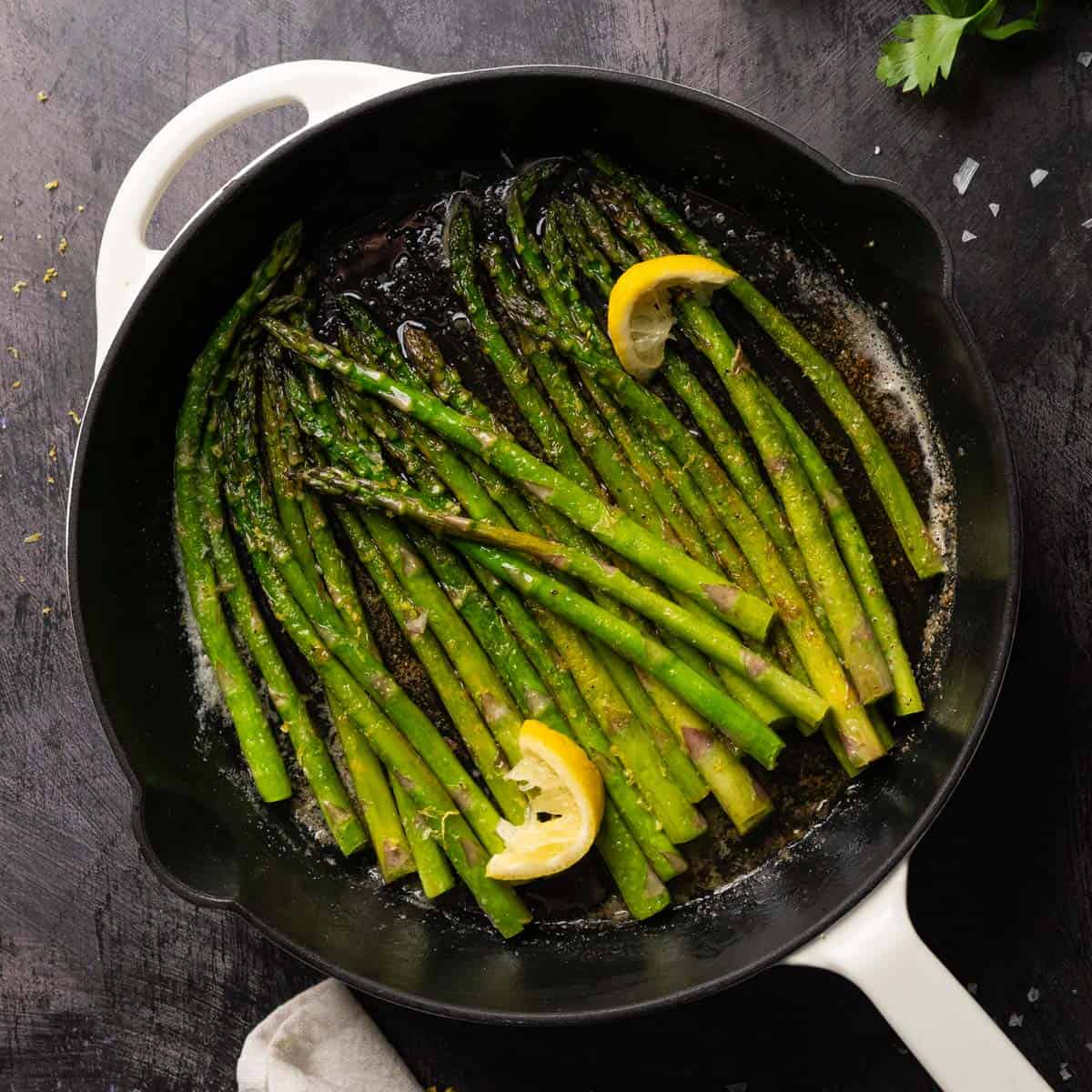
Pan Fried Asparagus
Video
Equipment
- Skillet cast iron or nonstick
- Spatula or tongs
Ingredients
- 2 Tablespoons Butter
- 1 Tablespoon Olive oil
- ½ teaspoon Salt
- ¼ teaspoon Black pepper
- ¼ teaspoon Garlic powder
- 1 lb Asparagus - trimmed
- 1 teaspoon Lemon juice
- ½ teaspoon Lemon zest - for garnish
Instructions
- Melt butter in a skillet over medium-high heat. Once melted, add the asparagus and toss in butter.2 Tablespoons Butter,1 lb Asparagus
- Add in olive oil, garlic powder, salt, and pepper. Mix well.1 Tablespoon Olive oil,½ teaspoon Salt,¼ teaspoon Black pepper,¼ teaspoon Garlic powder
- Cook until tender, turning the asparagus often to ensure even cooking, about 8-10 minutes.
- Garnish with lemon zest and a squeeze of fresh lemon juice. Serve your asparagus, and enjoy!1 teaspoon Lemon juice,½ teaspoon Lemon zest
Notes
- This side is delicious year-round, but I especially recommend it in spring when asparagus is in season. The difference in the quality is truly remarkable.
- A little sprinkle of parmesan on top of the asparagus complements the lemon beautifully.
- If you want to use fresh garlic, add it after the asparagus has cooked for a few minutes. That way it will season the butter and add flavor without risking burning and turning bitter.
- It's better to cook asparagus in batches versus over-crowding the pan! The secret to how to saute asparagus on the stove is to keep each spear in contact with the heat so it crisps nicely.
- If you can, roll or flip the asparagus spears instead of stirring them as they get close to done to keep their shape.



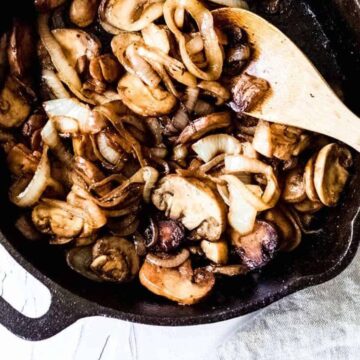
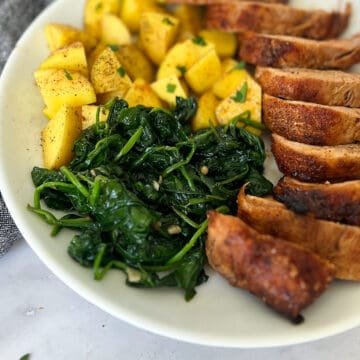
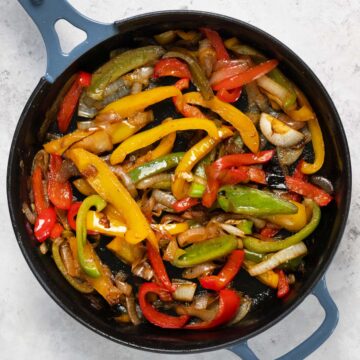

Comments
No Comments